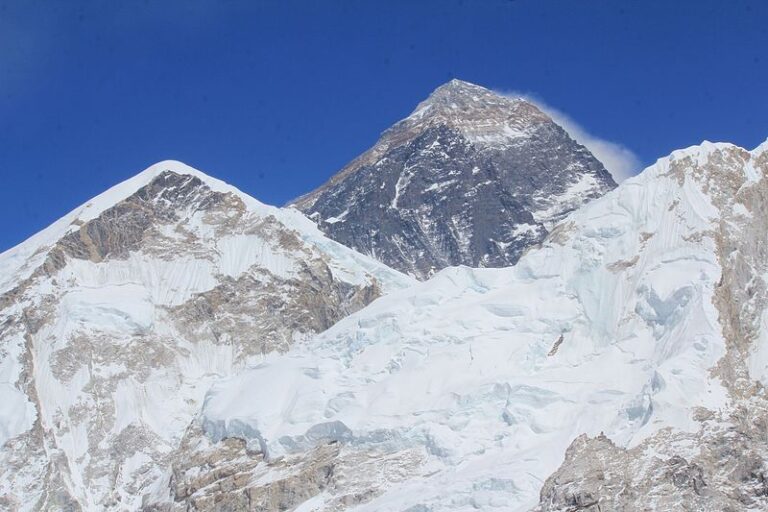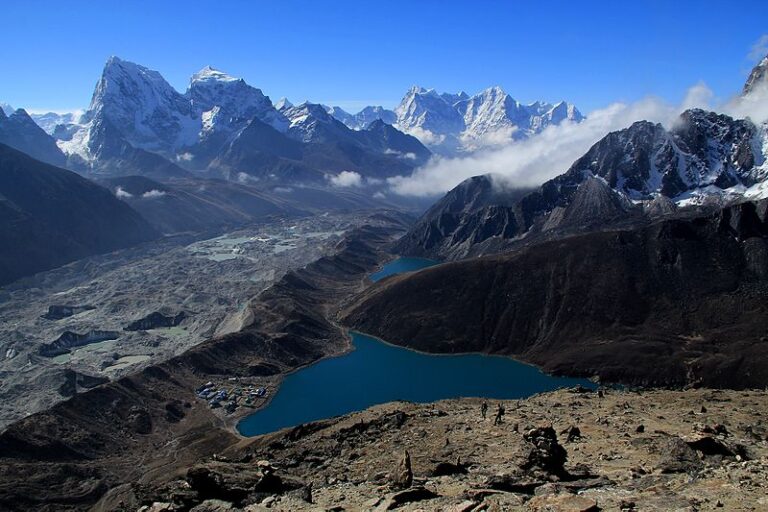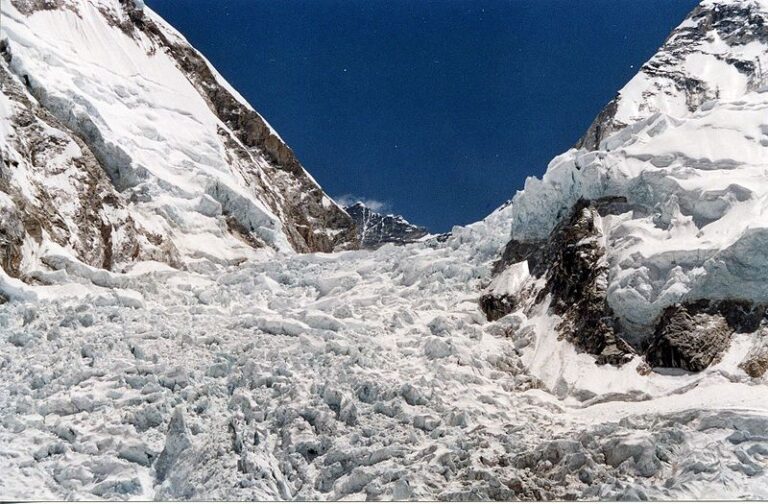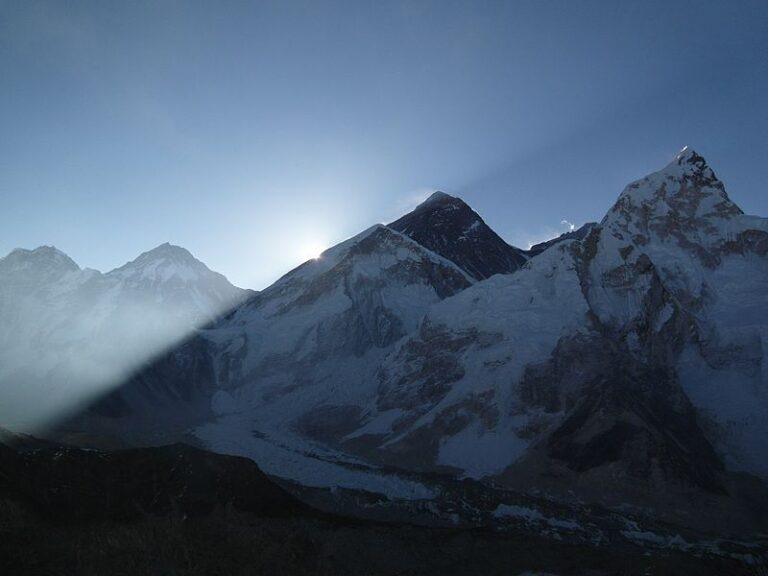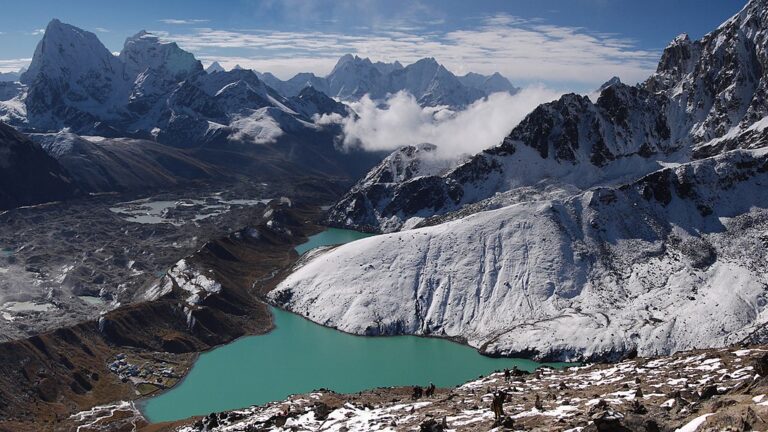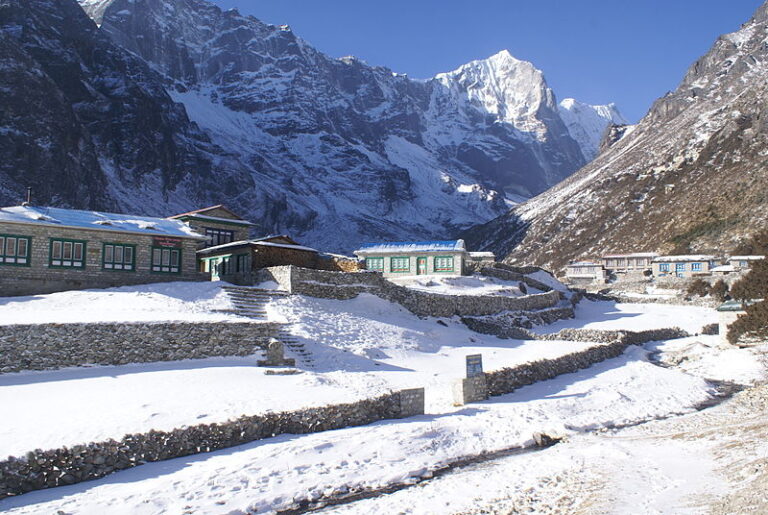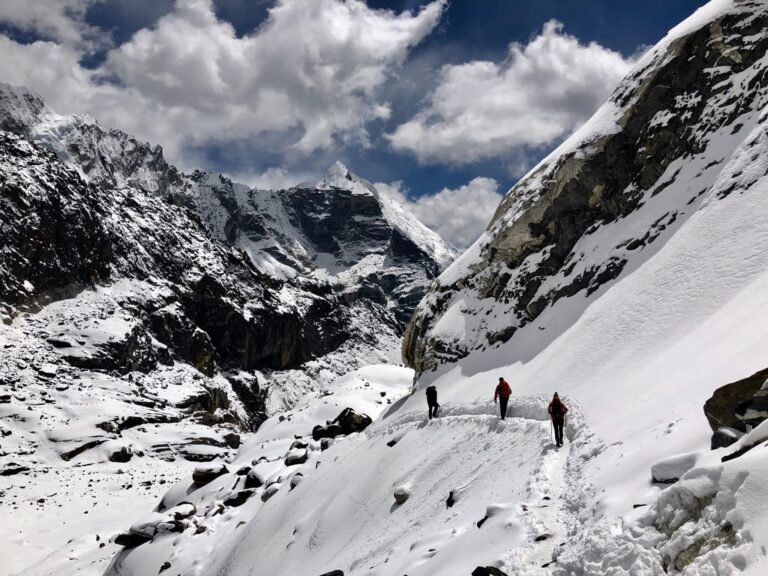Day 01 – pick you up from the Tribhuwan International Airport in Kathmandu and transfer to the hotel. Your hotel will be center of the Thamel; which is one of the tourist hubs of Kathmandu city.
Day 02 – Sight trip to the historical and ancient places around Kathmandu valley like the Pashupatinath Hindu temple, the Boudhanath stupa, Patan darbar square and the Swayambhunath stupa which is also known as monkey temple and brief about the trekking plan by the guide.
Day 03 – fly to Lukla and trek up to Phakding village (2610m.a.s.l) – 4 hours walks – we will fly about 30 minutes to get Lukla airport and trek continuously to Phakding village passing by many Sherpa villages with the view of Kongde, Nupla and Kusum kangaroo peak. Trekking from Lukla to Phakding would be a very joyful walk due to the flat trail that offers to see wonderful “mani walls”, spinning prayer wheels and prayer flag, which are hanging along the trail.
Day 04 – Trek to Namche bazaar (3440m.a.s.l) – 6 hours walks – the trail leads just along the bank of the Dudhkoshi River and pass by many Sherpa settlements called Toktok, Benkar, Monjo and Jorsalle village. From here you will also enjoy the view of Thamserku peak, green hills and some beautiful waterfalls. From the Jorsalle village trekkers have to walk on the flat trail about 30 minutes to get Larja dobhan where can be seen two awesome hanging bridges over the river. Then trekkers have to climb up about one and half hours to get Namche bazaar through the pine and the colored Rhododendron forest.
Day 05 – Acclimatization day – normally trekkers spend two nights in Namche bazaar for the acclimatization and the sight walks. There are many sight trips around the Namche bazaar, among them, also a sight trip to the Everest viewpoint that is being very popular due to the good view not only on the World highest Mountain, but also of Taboche, Thamserku, Amadablam, and Kongde peak. The Everest viewpoint is located just north side of the Namche bazaar and can be reached after one and half hours climb from the guesthouse of Namche bazaar.
Day 06 – Trek to Tengboche (3860m.a.s.l) – 6 hours walks – we have to climb up about 15 minutes to get top of the Namche bazaar then we will walk an approximately two hours on the flat trail to get Kyanjuma village with the view of Amadablam, Taboche, Thamserku and the deep valley of Fungitanga. Kyanjuma village is a trail junction for Gokyo valley and Everest base camp so we will turn to the right-hand side and trek down for approximately one and half hour to the Phungitanga through the pine and Rhododendron forest. From Phungitanga village we have to climb up about two hours to get Tengboche on a rocky step hill trail.
Day 07 – Trek to Dingboche village (4410m.a.s.l) – 5 hours walks – early in the morning we explore the 500 years old Tengboche monastery and trek towards to Dingboche village passing through the Sherpa Buddhist villages: Dibuche, Milingo, Pangboche and Somare. An area where is always possible to see many artistic “chorten”, Monasteries and “mani walls” which are made of thousands of stone slabs carved with deities and Buddhist incantation like the famous Mantra “OM MANE PADME HUM”. The trek from Tengboche to Dingboche is accompanied by the beautiful view on Amadablam, Cholatshe, Island peak, Lhotshe shar and a stunning view of the Nuptshe.
Day 08 – sight trip to Imja valley 4730m.a.s.l) – 5 hours walks – most of the trekkers choose the way to Lobuche from the Dingboche village, but to do the sight trip to Chhukung valley or Imja valley would be a valid alternative to be well acclimatized with the local environment. Besides the Chukung valley is one of the beautiful of the Khumbu region that leads to see closer view of Lhotshe shar, Island peak, Chukkung peak, shritshe, Nuptse and a wonderful view of the glacier of Lhotshe and Lhotshe Shar.
Day 09 – Trek over the Kongma-La pass and trek down to Lobuche (4700m.a.s.l) – 5 hours walks– The trail gently ascend from the yard of the guest house and leads through the bushy trail to get Kongma-La pass. After three and half hours uphill trail bring us to Kongma-La pass, which is 5545 meters high. The Kongma-La pass commands to see splendid views of Amadablam, Cholatse, Iceland, Lhotse, Lhotse shar, Nuptse, Pumori, Lobuche, Thamserku and including Mount Everest. After Kongma-La pass we will walk downhill trail for one and half-hours to get Khumbu glacier; from here we have to walk 45 minutes to get Lobuche village.
Day 10 – Trek to Gorakshep (5116m.a.s.l) – 4 hours walk – Trek from Lobuche to Gorakshep would be very pleasant walk due to walk on the flat and gradual up trail. While heading to Gorakshep we can have magnificent view of Nuptse, Pumori, Khumbutshe, Lingritshe, Lobuche, Cholatse and close view of Khumbu glacier. There are dozens of guesthouses in Lobuche and offers comfortable bed and delicious meals.
Day 11 – sight trip to Everest base camp (5380m.a.s.l) – 4 hours round trip – The Everest base camp is located eastern part of Gorakshep and takes an approximately two hours to get there. The Everest base camp offers to see awesome view of Pumori, Khumbutshe, Lingritshe, Nuptse, huge wall of Mount Everest and close view of Khumbu glacier. After sights of those things we will return back to Gorakshep. Sight trip to Kalapathar – Kalapathar is located just bottom of the Pumori peak and we have to climb approximately two hours to get there. Kalapathar viewpoint purpose to see close view of Pumori, Everest, Nuptse and beautiful sunset view on the background of the high Himalayas.
Day 12 – Trek to Jhongla village (4800m.a.s.l) – 5 hours walks – There is not any alternative trail to get back from Gorakshep so we have to trek back via same trail until Lobuche village. After Lobuche village we will walk half an hour on the main trekking trail of EBC trek then appear a signpost as way to Jhongla. we will turn to the right hand side trail and after two hours walk we will reach Jhongla village. While we are heading to Jhongla; can be seen magnificent mountain views and a high altitude lake called Cholatse Lake. There are half dozens of guesthouses in Jhongla village and offers comfortable bed and delicious meal.
Day 13 – Trek over the Chola pass (5380m.a.s.l and trek down to Thangnak village – Begins of the trek; we will walk on the gradual up trail for half an hour then the trail gently ascend to the Chola pass and an approximately three hours rocky and icy trail bring us to atop of the Chola pass. From the top of the Chola pass offers to see charm view of Amadablam, Lhotse shar, Makalu and its beautiful ranges. After taking some photographs; we will trek downhill trail for thee hours to get Thangnak village. While heading down to Jhongla village; we have to be very careful due to cross rock falling area.
Day 14 – Trek to Gokyo Lake (4800m.a.s.l) – 03 hours walks – Trek from Thangnak to Gokyo Lake would be very pleasant due to walk on the flat and on the huge glacier called Ngojumba. Most of the times we will walk on the Glacier and on a rocky path pass by several glacial lakes, which are made of melted Ngojumba glacier. We will have our lunch in Gokyo village then hang around the Gokyo Lake.
Day 15-Sight trip to Gokyo-Ri viewpoint (5360m.a.s.l) -05 hours round trip – there are many sight trips around the Gokyo valley like day hike up to 5th lake, day trip to Renjo –La pass and sight trip to Gokyo-Ri peak but still sight trip to Gokyo-Ri view point is being popular than others because its commands to the trekkers to see magnificent view of Cho-Oyu, Gokyo lake, Cholatse peak, Cholo peak, Ngojumba glaciers and as well as the far view of Mount Everest and Makalu.
Day 16 – Trek from Gokyo Lake to Thame (4368m.a.s.l) – 7 hours walks – we will start our trek little bit earlier than previous days due to cross Renjo-La pass which is 5360 meters high. Begins of the morning; we will walk on the flat trail, beside the Gokyo lake for one and half hours then we will ascend an approximately two hours to get top of the Renjo-La. From the top of the Renjo-La, we can see mind blowing view of Cho-Oyu 8201 m, Everest 8848 m, Lhotse 8516 m, Cholatse 6440 m and stunning view of Gokyo Lake and Ngojumba glacier. After splendid view of high Himalayas, we will descends to the Lumde doing by downhill trail through the glacial moraines and spend a joyful night in Lumde village.
Day 17 – Trek from Lumde village to Thame village (3800m.a.s.l) -5 hours walks – we will trek down to the Thame village pass by Dinjung, Taranga and Yilajung villages through the moraines and along the ancient route used by the traders to transfer goods across Tibet via Nangpa-La pass. The trek of the day would be very pleasant due to see superb mountain views, sights of small monasteries and the view of Bhote Koshi River.
Day 18 – Trek from Thame to Namche Bazaar (3440m.a.s.l) – 5 hours walks – Trek begins along the Bhote koshi River pass by stumbling Chhortens, Stupa, Mani walls and monasteries with relishing panoramic view of snow-capped peaks. Most of the time we will walk through the forested trail of Juniper, pasture land so along the trail can be seen hundreds of grazing yaks, horses, Deer and as well as blue sheep and Himalayan Thar.
Day 19-Trek from Namche Bazaar to Phakding village (2610m.a.s.l) – 5 hours walks- begin of the morning we will walk downhill trail an about one hour to get Larja dobhan then rest of the trek to Phakding village is very pleasant walk due to walk through the forest with the view of green landscape and vista stunning view of Thamserku peak.
Day 20-Trek from Phakding to Lukla Bazaar (2840m.a.s.l – 5 hours walks – we will pass many Sherpa villages called Ghat, Thadokoshi, Chheplung and Chaurikharka with the view of Kusum kangaroo and Kongde peak. Along the trail we will see many Chhortens, Stupa, monasteries and Buddhist incantation, which are carved on the huge rocks of the center of the trail.
Day 21- Fly back to Kathmandu – Early in the morning we will fly about 30 minutes to get Kathmandu valley. During the flight we will magnificent view high Himalayan ranges called, Annapurna, Dhaulagiri, Manaslu, Ganesh Himal, Gaurishankar Himal ranges including superb view of Mount Everest.
Day 22 – final departure – After successful trip of three high passes trek, you will fly back to your home with great experience of outdoor and many tales about Nepal, Nepalese culture, jungles, mountains, traditions and costumes that makes you a storyteller among your friends and colloquies.
